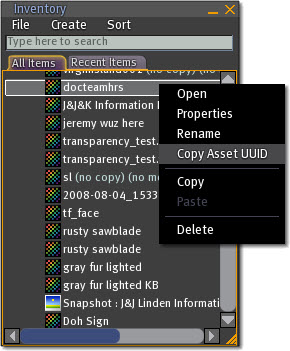What is an avatar key?

This article is part of the Extended Second Life Knowledge Base that includes advanced and specialized information. This information was originally provided by Linden Lab, but is not actively maintained nor guaranteed to be accurate. Linden Lab does not certify nor assume any responsibility for this information.
See the official Second Life Knowledge Base for the most current information.
UUID is an initialism for the term Universally Unique Identifier. Every avatar, object, and inventory item in the Second LifeÃâ® world has a UUID; scripted objects often make use of UUIDs to identify avatars and objects, load textures, and play sounds.
| Trivia: Trivia: In Second Life, the term UUID is interchangeable with the word key. If you hear someone talking about an "avatar key", they are referring to an avatar's UUID. |
How to find an avatar's UUID
You may occasionally need to know an avatar's UUID; some vending machines and other scripted objects require a valid avatar UUID to function properly. Luckily, finding an avatar's UUID is as easy as performing a simple search:
- Click the Search button at the bottom of your Second Life viewer window.
- Click the All tab on the Search window.
- Choose People from the dropdown box to the right of the search field. [Optional]
- Type the name of the avatar into the search field and press Search.
- Click the avatar's name in the search results.
- At the bottom of the avatar's profile, find the URL next to "Link to this page."
- The long string of letters and numbers after the last forward slash ("/") is that avatar's UUID.
How to find the UUID of an inventory item
If you make extensive use of LSL scripts, you may want to know the UUID of a texture or sound in your avatar's inventory. You can easily copy any inventory item's UUID to your computer's clipboard by right-clicking it and selecting Copy Asset UUID:
Caveats
This method is great for finding sound and texture UUIDs, but is not always effective for other inventory types. Here is a short list of exceptions:
- A notecard's UUID changes every time it is edited and saved.
- There is no way to find an object's UUID until it is rezzed inworld; this is because each rezzed copy of the object must have a unique UUID. Similarly, if you take an object into your inventory, it is assigned a new UUID the next time you rez it.
- There is no way to find an LSL script's UUID while it is in your inventory, for similar reasons.
- You must have full permissions on any inventory item to copy its UUID; this also applies to calling cards, which are by nature "no-transfer" items.
Other resources
LSL has several that can help determine an object or avatar's UUID. If you are interested in learning to use LSL for this purpose, you should visit the LSL Portal on the Second Life Wiki.
